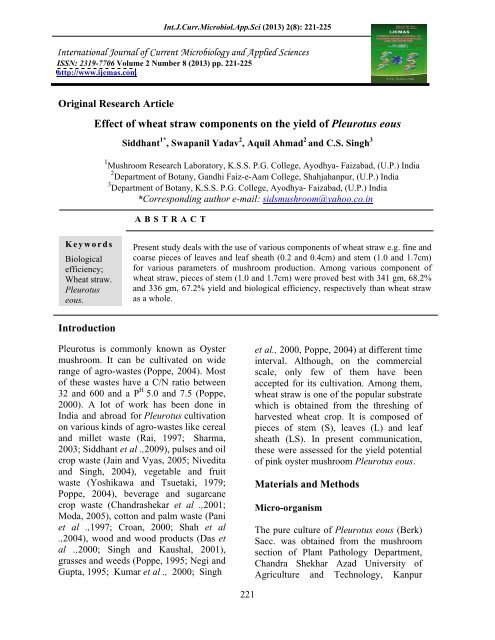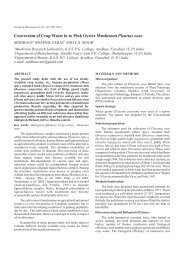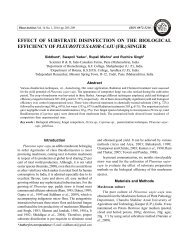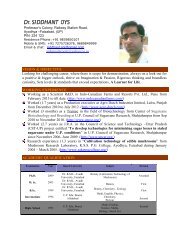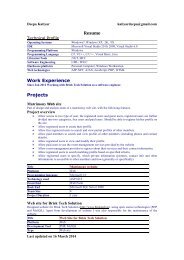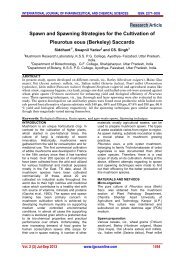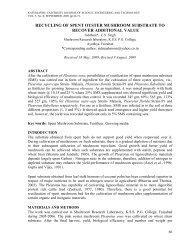You also want an ePaper? Increase the reach of your titles
YUMPU automatically turns print PDFs into web optimized ePapers that Google loves.
Int.J.Curr.Microbiol.App.Sci (2013) 2(8): 221-225<br />
ISSN: 2319-7706 Volume 2 Number 8 (2013) pp. 221-225<br />
http://www.ijcmas.com<br />
Original Research Article<br />
<str<strong>on</strong>g>Effect</str<strong>on</strong>g> <str<strong>on</strong>g>of</str<strong>on</strong>g> <str<strong>on</strong>g>wheat</str<strong>on</strong>g> <str<strong>on</strong>g>straw</str<strong>on</strong>g> <str<strong>on</strong>g>comp<strong>on</strong>ents</str<strong>on</strong>g> <strong>on</strong> <strong>the</strong> <strong>yield</strong> <str<strong>on</strong>g>of</str<strong>on</strong>g> <strong>Pleurotus</strong> <strong>eous</strong><br />
Siddhant 1* , Swapanil Yadav 2 , Aquil Ahmad 2 and C.S. Singh 3<br />
1 Mushroom Research Laboratory, K.S.S. P.G. College, Ayodhya- Faizabad, (U.P.) India<br />
2 Department <str<strong>on</strong>g>of</str<strong>on</strong>g> Botany, Gandhi Faiz-e-Aam College, Shahjahanpur, (U.P.) India<br />
3 Department <str<strong>on</strong>g>of</str<strong>on</strong>g> Botany, K.S.S. P.G. College, Ayodhya- Faizabad, (U.P.) India<br />
*Corresp<strong>on</strong>ding author e-mail: sidsmushroom@yahoo.co.in<br />
A B S T R A C T<br />
K e y w o r d s<br />
Biological<br />
efficiency;<br />
Wheat <str<strong>on</strong>g>straw</str<strong>on</strong>g>.<br />
<strong>Pleurotus</strong><br />
<strong>eous</strong>.<br />
Present study deals with <strong>the</strong> use <str<strong>on</strong>g>of</str<strong>on</strong>g> various <str<strong>on</strong>g>comp<strong>on</strong>ents</str<strong>on</strong>g> <str<strong>on</strong>g>of</str<strong>on</strong>g> <str<strong>on</strong>g>wheat</str<strong>on</strong>g> <str<strong>on</strong>g>straw</str<strong>on</strong>g> e.g. fine and<br />
coarse pieces <str<strong>on</strong>g>of</str<strong>on</strong>g> leaves and leaf sheath (0.2 and 0.4cm) and stem (1.0 and 1.7cm)<br />
for various parameters <str<strong>on</strong>g>of</str<strong>on</strong>g> mushroom producti<strong>on</strong>. Am<strong>on</strong>g various comp<strong>on</strong>ent <str<strong>on</strong>g>of</str<strong>on</strong>g><br />
<str<strong>on</strong>g>wheat</str<strong>on</strong>g> <str<strong>on</strong>g>straw</str<strong>on</strong>g>, pieces <str<strong>on</strong>g>of</str<strong>on</strong>g> stem (1.0 and 1.7cm) were proved best with 341 gm, 68.2%<br />
and 336 gm, 67.2% <strong>yield</strong> and biological efficiency, respectively than <str<strong>on</strong>g>wheat</str<strong>on</strong>g> <str<strong>on</strong>g>straw</str<strong>on</strong>g><br />
as a whole.<br />
Introducti<strong>on</strong><br />
<strong>Pleurotus</strong> is comm<strong>on</strong>ly known as Oyster<br />
mushroom. It can be cultivated <strong>on</strong> wide<br />
range <str<strong>on</strong>g>of</str<strong>on</strong>g> agro-wastes (Poppe, 2004). Most<br />
<str<strong>on</strong>g>of</str<strong>on</strong>g> <strong>the</strong>se wastes have a C/N ratio between<br />
32 and 600 and a P H 5.0 and 7.5 (Poppe,<br />
2000). A lot <str<strong>on</strong>g>of</str<strong>on</strong>g> work has been d<strong>on</strong>e in<br />
India and abroad for <strong>Pleurotus</strong> cultivati<strong>on</strong><br />
<strong>on</strong> various kinds <str<strong>on</strong>g>of</str<strong>on</strong>g> agro-wastes like cereal<br />
and millet waste (Rai, 1997; Sharma,<br />
2003; Siddhant et al .,2009), pulses and oil<br />
crop waste (Jain and Vyas, 2005; Nivedita<br />
and Singh, 2004), vegetable and fruit<br />
waste (Yoshikawa and Tsuetaki, 1979;<br />
Poppe, 2004), beverage and sugarcane<br />
crop waste (Chandrashekar et al .,2001;<br />
Moda, 2005), cott<strong>on</strong> and palm waste (Pani<br />
et al .,1997; Croan, 2000; Shah et al<br />
.,2004), wood and wood products (Das et<br />
al .,2000; Singh and Kaushal, 2001),<br />
grasses and weeds (Poppe, 1995; Negi and<br />
Gupta, 1995; Kumar et al ., 2000; Singh<br />
et al., 2000, Poppe, 2004) at different time<br />
interval. Although, <strong>on</strong> <strong>the</strong> commercial<br />
scale, <strong>on</strong>ly few <str<strong>on</strong>g>of</str<strong>on</strong>g> <strong>the</strong>m have been<br />
accepted for its cultivati<strong>on</strong>. Am<strong>on</strong>g <strong>the</strong>m,<br />
<str<strong>on</strong>g>wheat</str<strong>on</strong>g> <str<strong>on</strong>g>straw</str<strong>on</strong>g> is <strong>on</strong>e <str<strong>on</strong>g>of</str<strong>on</strong>g> <strong>the</strong> popular substrate<br />
which is obtained from <strong>the</strong> threshing <str<strong>on</strong>g>of</str<strong>on</strong>g><br />
harvested <str<strong>on</strong>g>wheat</str<strong>on</strong>g> crop. It is composed <str<strong>on</strong>g>of</str<strong>on</strong>g><br />
pieces <str<strong>on</strong>g>of</str<strong>on</strong>g> stem (S), leaves (L) and leaf<br />
sheath (LS). In present communicati<strong>on</strong>,<br />
<strong>the</strong>se were assessed for <strong>the</strong> <strong>yield</strong> potential<br />
<str<strong>on</strong>g>of</str<strong>on</strong>g> pink oyster mushroom <strong>Pleurotus</strong> <strong>eous</strong>.<br />
Materials and Methods<br />
Micro-organism<br />
The pure culture <str<strong>on</strong>g>of</str<strong>on</strong>g> <strong>Pleurotus</strong> <strong>eous</strong> (Berk)<br />
Sacc. was obtained from <strong>the</strong> mushroom<br />
secti<strong>on</strong> <str<strong>on</strong>g>of</str<strong>on</strong>g> Plant Pathology Department,<br />
Chandra Shekhar Azad University <str<strong>on</strong>g>of</str<strong>on</strong>g><br />
Agriculture and Technology, Kanpur<br />
221
Int.J.Curr.Microbiol.App.Sci (2013) 2(8): 221-225<br />
(U.P.) India. The culture was maintained<br />
and subcultured <strong>on</strong> potato dextrose agar<br />
(PDA) medium.<br />
Spawn strategy<br />
Wheat grains (Triticum aestivum) were<br />
used as a spawn substrate. The spawn was<br />
prepared by <strong>the</strong> c<strong>on</strong>venti<strong>on</strong>al method.<br />
Substrate preparati<strong>on</strong><br />
Different comp<strong>on</strong>ent <str<strong>on</strong>g>of</str<strong>on</strong>g> <str<strong>on</strong>g>wheat</str<strong>on</strong>g> <str<strong>on</strong>g>straw</str<strong>on</strong>g>,<br />
viz., fine pieces <str<strong>on</strong>g>of</str<strong>on</strong>g> L and LS (0.2<br />
cm), coarse pieces <str<strong>on</strong>g>of</str<strong>on</strong>g> L and LS<br />
(0.4cm), small (1.0cm) and large pieces <str<strong>on</strong>g>of</str<strong>on</strong>g><br />
stem(1.7 cm) were washed separately in<br />
fresh water and <strong>the</strong>n pasteurized in <strong>the</strong><br />
soluti<strong>on</strong> <str<strong>on</strong>g>of</str<strong>on</strong>g> Formaldehyde (500ppm) and<br />
Bavistin (75ppm) for 18 hours as<br />
recommended by Vijay and Sohi (1987).<br />
Method <str<strong>on</strong>g>of</str<strong>on</strong>g> cultivati<strong>on</strong><br />
The beds were prepared from pasteurized<br />
substrate by layer spawning following <strong>the</strong><br />
procedure <str<strong>on</strong>g>of</str<strong>on</strong>g> Bano (1971). These were<br />
incubated in a cultivati<strong>on</strong> room at 22-30°C<br />
for spawn running. When mycelium had<br />
completely covered <strong>the</strong> beds, <strong>the</strong><br />
poly<strong>the</strong>ne covering was taken <str<strong>on</strong>g>of</str<strong>on</strong>g>f and <strong>the</strong><br />
relative humidity was maintained 85-95 %<br />
with <strong>the</strong> help <str<strong>on</strong>g>of</str<strong>on</strong>g> humidifier.<br />
Data c<strong>on</strong>cerning and Biological<br />
efficiency<br />
The <strong>yield</strong> parameters recorded were, time<br />
lapsed in spawn running, pin head<br />
initiati<strong>on</strong> and maturity <str<strong>on</strong>g>of</str<strong>on</strong>g> fruit bodies,<br />
number <str<strong>on</strong>g>of</str<strong>on</strong>g> flushes, mushroom <strong>yield</strong>,<br />
biological efficiency, total number and<br />
weight per sporocarp <strong>on</strong> different crop<br />
waste. The biological efficiency <str<strong>on</strong>g>of</str<strong>on</strong>g><br />
mushroom was worked out as percentage<br />
<strong>yield</strong> <str<strong>on</strong>g>of</str<strong>on</strong>g> fresh mushrooms in relati<strong>on</strong> to <strong>the</strong><br />
dry weight <str<strong>on</strong>g>of</str<strong>on</strong>g> <strong>the</strong> substrate according to<br />
Chang and Miles (1989).<br />
Yield <str<strong>on</strong>g>of</str<strong>on</strong>g> fresh mushroom (gm)<br />
Biological efficiency = --------------- × 100<br />
Total weight <str<strong>on</strong>g>of</str<strong>on</strong>g> dry substrate used (gm)<br />
Statistical analysis<br />
Completely randomized design (CRD)<br />
was followed for <strong>the</strong> experiment. All data<br />
were statistically analysed. The critical<br />
difference (CD) was processed at <strong>the</strong> five<br />
per cent probability level.<br />
Results and Discussi<strong>on</strong><br />
The comp<strong>on</strong>ent had variable effects <strong>on</strong><br />
durati<strong>on</strong> <str<strong>on</strong>g>of</str<strong>on</strong>g> spawn running, pinning and<br />
fruit body maturati<strong>on</strong>, which ranged from<br />
15-24 days, 18-29 days and 22-34 days,<br />
respectively (Table). The fine<br />
and coarse comp<strong>on</strong>ent i.e. pieces <str<strong>on</strong>g>of</str<strong>on</strong>g> leaf<br />
and leaf sheath took l<strong>on</strong>ger durati<strong>on</strong> in<br />
aforesaid manifestati<strong>on</strong>s. It was due to less<br />
air space available and much water<br />
holding capacity <str<strong>on</strong>g>of</str<strong>on</strong>g> <strong>the</strong> substrate<br />
particles. They also showed decrease in<br />
<strong>yield</strong> with greater incidence <str<strong>on</strong>g>of</str<strong>on</strong>g><br />
c<strong>on</strong>taminati<strong>on</strong>. Low biological efficiency<br />
<str<strong>on</strong>g>of</str<strong>on</strong>g> mushrooms might be due to less food<br />
material available in L and LS<br />
while susceptibility against c<strong>on</strong>taminants<br />
was possibly due to presence <str<strong>on</strong>g>of</str<strong>on</strong>g> dust<br />
particles that provide inoculum for <strong>the</strong><br />
development <str<strong>on</strong>g>of</str<strong>on</strong>g> competitors.<br />
The highest <strong>yield</strong> was obtained from <strong>the</strong><br />
small and large pieces <str<strong>on</strong>g>of</str<strong>on</strong>g> stem with 341 g,<br />
68.2% and 336 g, 67.2 %, respectively.<br />
Statistically, <strong>the</strong>se were at par to each<br />
o<strong>the</strong>r. Absence <str<strong>on</strong>g>of</str<strong>on</strong>g> c<strong>on</strong>taminants al<strong>on</strong>g with<br />
higher <strong>yield</strong> revealed <strong>the</strong> importance <str<strong>on</strong>g>of</str<strong>on</strong>g><br />
<strong>the</strong>se <str<strong>on</strong>g>comp<strong>on</strong>ents</str<strong>on</strong>g>.<br />
222
Int.J.Curr.Microbiol.App.Sci (2013) 2(8): 221-225<br />
Table <str<strong>on</strong>g>Effect</str<strong>on</strong>g> <str<strong>on</strong>g>of</str<strong>on</strong>g> different comp<strong>on</strong>ent <str<strong>on</strong>g>of</str<strong>on</strong>g> <str<strong>on</strong>g>wheat</str<strong>on</strong>g> <str<strong>on</strong>g>straw</str<strong>on</strong>g> <strong>on</strong> mushroom producti<strong>on</strong><br />
Comp<strong>on</strong>ent <str<strong>on</strong>g>of</str<strong>on</strong>g><br />
<str<strong>on</strong>g>wheat</str<strong>on</strong>g> <str<strong>on</strong>g>straw</str<strong>on</strong>g><br />
Spawn run<br />
(Days)<br />
Primordial<br />
development<br />
(Days)<br />
First harvest<br />
(Days)<br />
Total <strong>yield</strong> from<br />
three flushes [g/500<br />
g dry substrate]<br />
Biological<br />
efficiency<br />
(%)<br />
Average<br />
number <str<strong>on</strong>g>of</str<strong>on</strong>g><br />
sporocarp<br />
Weight per<br />
sporocarp<br />
(g)<br />
Fine pieces <str<strong>on</strong>g>of</str<strong>on</strong>g> L and<br />
LS (0.2 cm)<br />
24 29 34 218 43.6 69 3.15<br />
Coarse pieces <str<strong>on</strong>g>of</str<strong>on</strong>g> L<br />
and LS(0.4 cm)<br />
22 27 31 260 52.0 68 3.82<br />
Pieces <str<strong>on</strong>g>of</str<strong>on</strong>g> stem (1.0<br />
cm)<br />
15 18 22 341 68.2 56 6.08<br />
Pieces <str<strong>on</strong>g>of</str<strong>on</strong>g> stem (1.7<br />
cm)<br />
15 18 22 336 67.2 58 5.79<br />
C<strong>on</strong>trol 16 19 23 301 60.2 44 6.84<br />
SE -- -- -- 13.18 2.63 5.24 0.39<br />
CD (P=0.05) -- -- -- 29.39 5.87 11.68 0.88<br />
L: Leaf, LS: Leaf Sheath; Average <str<strong>on</strong>g>of</str<strong>on</strong>g> three replicati<strong>on</strong><br />
223
Int.J.Curr.Microbiol.App.Sci (2013) 2(8): 221-225<br />
Based <strong>on</strong> <strong>the</strong> investigati<strong>on</strong>s, mushroom<br />
farmers are advised to avoid pieces <str<strong>on</strong>g>of</str<strong>on</strong>g><br />
leaves and leaf sheath while collecting<br />
<str<strong>on</strong>g>wheat</str<strong>on</strong>g> <str<strong>on</strong>g>straw</str<strong>on</strong>g> from <strong>the</strong> site <str<strong>on</strong>g>of</str<strong>on</strong>g> harvesting.<br />
Acknowledgement<br />
The authors are thankful to<br />
Dr. B.P. Kanaujia, C.S.A. University <str<strong>on</strong>g>of</str<strong>on</strong>g><br />
Agriculture and Technology, Kanpur for<br />
providing <strong>the</strong> culture <str<strong>on</strong>g>of</str<strong>on</strong>g> <strong>Pleurotus</strong> <strong>eous</strong><br />
and <strong>the</strong> Principal K.S.S.P.G. College,<br />
Ayodhya- Faizabad for laboratory and<br />
library facilities.<br />
References<br />
Bano, Z., 1971. Cultivati<strong>on</strong> <str<strong>on</strong>g>of</str<strong>on</strong>g> <strong>Pleurotus</strong><br />
flabellatus. Sec<strong>on</strong>d Int. Symp. Pl.<br />
Pathol., New Delhi. (Abstract No.<br />
135).<br />
Chandrashekar, B.S., V. Savalgi and<br />
Kulkarni, J.H. 2001. Cultivati<strong>on</strong> trails<br />
<str<strong>on</strong>g>of</str<strong>on</strong>g> <strong>Pleurotus</strong> sajor-caju (Fr.) Singer <strong>on</strong><br />
sodium hydroxide pretreated sugarcane<br />
by-products. Mush. Res.10(1): 27-30.<br />
Chang, S.T., and Miles, P.G. 1989. Edible<br />
mushrooms and <strong>the</strong>ir cultivati<strong>on</strong>, CRC<br />
Press, Boca Rat<strong>on</strong>, pp. 256-274.<br />
Croan, S.C., 2000. C<strong>on</strong>versi<strong>on</strong> <str<strong>on</strong>g>of</str<strong>on</strong>g> wood<br />
waste into value-added products by<br />
edible and medicinal <strong>Pleurotus</strong> (F.) P.<br />
Karst. Species (Agaricales s.l.,<br />
Basidiomycetes). Inter.J. Med.<br />
Mushroom 2:73-80.<br />
Das, N., S.C. Mahapatra and<br />
Chattopadhyay, R.N. 2000. Use <str<strong>on</strong>g>of</str<strong>on</strong>g><br />
wild grasses as substrate for <strong>the</strong><br />
cultivati<strong>on</strong> <str<strong>on</strong>g>of</str<strong>on</strong>g> oyster mushroom in<br />
South West Bengal. Mush. Res. 9(2):<br />
95-99.<br />
Jain, A.K., and Vyas, D., 2005.<br />
Comparative study <strong>on</strong> <strong>the</strong> <strong>yield</strong> <str<strong>on</strong>g>of</str<strong>on</strong>g><br />
three <strong>Pleurotus</strong> species grown in<br />
several lignocellulosic by-products. J.<br />
Basic Appl. Mycol. 4(I&II): 155-157.<br />
Kumar, P., J. Pal and Sharma, B.M. 2000.<br />
Cultivati<strong>on</strong> <str<strong>on</strong>g>of</str<strong>on</strong>g> <strong>Pleurotus</strong> sajor-caju <strong>on</strong><br />
different substrates. Mushroom Res.<br />
9(1): 43-45.<br />
Moda, E.M., J. Horii and Spoto, M.H.F.<br />
2005. Edible mushroom <strong>Pleurotus</strong><br />
sajor-caju producti<strong>on</strong> <strong>on</strong> washed and<br />
supplemented sugarcane bagasse.<br />
Scientia Agricola (Piracicaba, Braz.)<br />
62(2): 127-132.<br />
Negi, P.S., and Gupta, R.C. 1995.<br />
Cannabis sativa (Bhang) leaves a<br />
suitable substrate to cultivate<br />
<strong>Pleurotus</strong> sajor-caju. Indian J. Mycol.<br />
Pl. Pathol. 25 (3): 304-305.<br />
Nivedita, L., and Singh, N. I. 2004.<br />
Lignocellulose degradati<strong>on</strong> by<br />
mushroom (<strong>Pleurotus</strong> ostreatus).<br />
Envir<strong>on</strong>. Biol. C<strong>on</strong>ser. 9: 89-90.<br />
Pani,B., S. Panda and Das, S. 1997.<br />
Utilizati<strong>on</strong> <str<strong>on</strong>g>of</str<strong>on</strong>g> some by-products and<br />
o<strong>the</strong>r wastes for sporophore producti<strong>on</strong><br />
<str<strong>on</strong>g>of</str<strong>on</strong>g> oyster mushroom. Orissa J.<br />
Horticult. 25(1): 36-39.<br />
Poppe, J., 1995. Cultivati<strong>on</strong> <str<strong>on</strong>g>of</str<strong>on</strong>g> Edible<br />
Mushrooms <strong>on</strong> tropical agricultural<br />
wastes. Biennial Training course.<br />
ABOS & VLIR. University Gent.<br />
Poppe, J., 2000. Use <str<strong>on</strong>g>of</str<strong>on</strong>g> agricultural waste<br />
materials in <strong>the</strong> cultivati<strong>on</strong> <str<strong>on</strong>g>of</str<strong>on</strong>g><br />
mushrooms. In: L. Van Griensven:<br />
Proceedings 15th Internati<strong>on</strong>al<br />
C<strong>on</strong>gress <strong>on</strong> Science and Cultivati<strong>on</strong><br />
<str<strong>on</strong>g>of</str<strong>on</strong>g> Edible Fungi, Balkema Rotterdam,<br />
3-23.<br />
Poppe, J., 2004. Agricultural wastes as<br />
substrate for oyster mushroom. In:<br />
Mushroom Growers Handbook1,<br />
5:75-85.<br />
Rai, B.K., 1997. Cultivati<strong>on</strong> <str<strong>on</strong>g>of</str<strong>on</strong>g> oyster<br />
mushroom <strong>on</strong> <str<strong>on</strong>g>straw</str<strong>on</strong>g>s.<br />
VASUNDHARA (Internati<strong>on</strong>al J.<br />
Envir<strong>on</strong>. Biol. 2: 83-84.<br />
Shah, Z.A., M. Ashraf and Ishtiaq, Ch. M.<br />
224
Int.J.Curr.Microbiol.App.Sci (2013) 2(8): 221-225<br />
2004. Comparative study <strong>on</strong><br />
cultivati<strong>on</strong> and <strong>yield</strong> performance <str<strong>on</strong>g>of</str<strong>on</strong>g><br />
oyster mushroom (<strong>Pleurotus</strong> ostreatus)<br />
<strong>on</strong> different substrates (Wheat <str<strong>on</strong>g>straw</str<strong>on</strong>g>,<br />
Leaves, Saw Dust). Pakistan Journal <str<strong>on</strong>g>of</str<strong>on</strong>g><br />
Nutiti<strong>on</strong> 3(3): 158-160.<br />
Sharma, B.B., 2003. <str<strong>on</strong>g>Effect</str<strong>on</strong>g> <str<strong>on</strong>g>of</str<strong>on</strong>g> different<br />
substrate (Grain/ Straw) <strong>on</strong> spawn<br />
growth and <strong>yield</strong> <str<strong>on</strong>g>of</str<strong>on</strong>g> pink oyster<br />
mushroom <strong>Pleurotus</strong> djamor (Fr.)<br />
Boedijn. J. Mycol. Pl. Pathol., 33(2):<br />
265-268.<br />
Siddhant, R. Singh and Kanaujia, R.S.<br />
2009. Cultivati<strong>on</strong> <str<strong>on</strong>g>of</str<strong>on</strong>g> <strong>Pleurotus</strong><br />
flabellatus (Berk. Et Br.) Sacc. using<br />
different waste substrates. Journal <str<strong>on</strong>g>of</str<strong>on</strong>g><br />
<strong>the</strong> Indian Botanical Society<br />
88(1&2):137-139.<br />
Singh, C.S., A.B. Prasad and Kanaujia,<br />
R.S. 1991. Naked patsan stem sticks: a<br />
promising substrate for <strong>the</strong> cultivati<strong>on</strong><br />
<str<strong>on</strong>g>of</str<strong>on</strong>g> <strong>Pleurotus</strong> sajor-caju. Indian<br />
Phytopathol. Z<strong>on</strong>al Meeting,<br />
(Abstract72).<br />
Singh, M.P., and Kaushal, S.C. 2001.<br />
Comm<strong>on</strong> grass- a potent substrate <str<strong>on</strong>g>of</str<strong>on</strong>g><br />
oyster mushroom. Mush. Res. 10(1):<br />
43-45.<br />
Vijay, B., and Sohi, H.S. 1987. Cultivati<strong>on</strong><br />
<str<strong>on</strong>g>of</str<strong>on</strong>g> oyster mushroom <strong>Pleurotus</strong> sajorcaju<br />
(Fr.) Singer <strong>on</strong> chemically<br />
sterilized <str<strong>on</strong>g>wheat</str<strong>on</strong>g> <str<strong>on</strong>g>straw</str<strong>on</strong>g>. Mush. J.<br />
Tropics 7: 67-75.<br />
Yoshikawa, K., and Tsuetaki, N., 1979.<br />
Utilizati<strong>on</strong> <str<strong>on</strong>g>of</str<strong>on</strong>g> citrus unshiu peels as<br />
primary substrate for edible mushroom<br />
cultivati<strong>on</strong>. Hakkokogaku Kaishi<br />
57(6): 467-488.<br />
225


